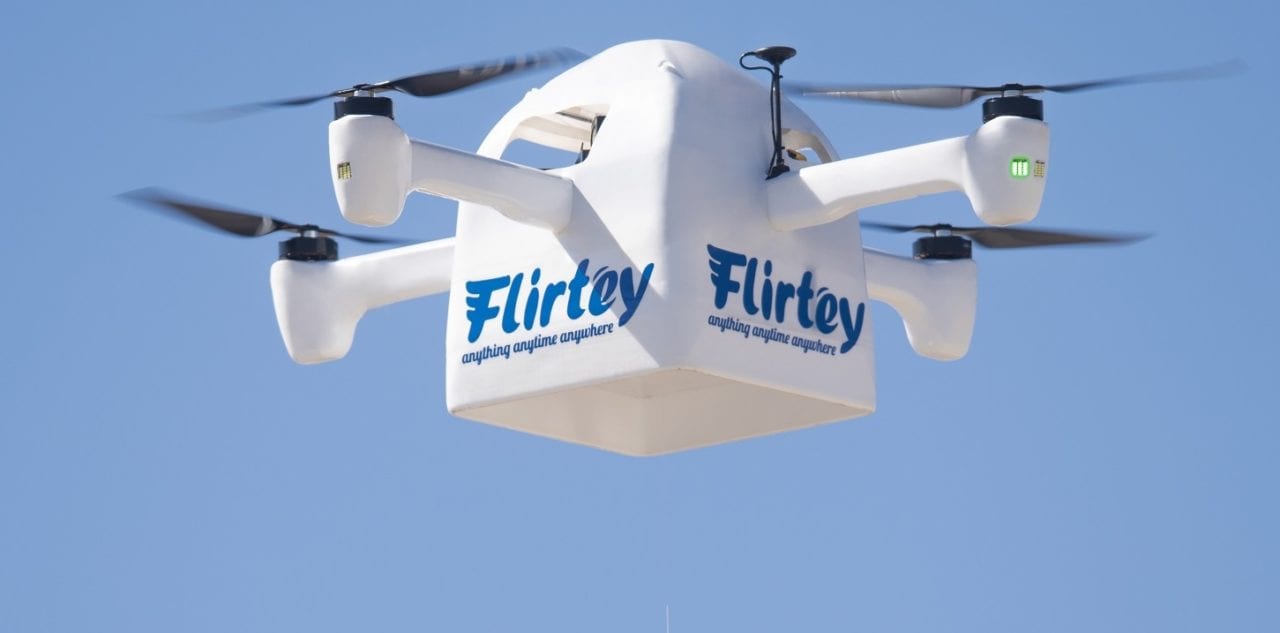
Flirtey’s new ‘Eagle’ drone is capable of flying in “95 percent of weather conditions,” according to the company. (Flirtey)
WASHINGTON, D.C. — Drone delivery startup Flirtey is enabling rapid point-to-point drone delivery using a new commercial drone, a portable drone launch point and autonomous software that is FAA-approved to allow one operator to oversee the operations of ten drones simultaneously. The company hopes to gain approval for commercial operations next year and begin to scale nationwide.
The Reno, Nevada-based company, which completed the first FAA-approved drone delivery in 2015 as part of the UAS Integration Pilot Program (IPP), unveiled its new Eagle drone, alongside a Portal that can be parked in a central location and used to dispatch the Eagle to local delivery targets.
Flirtey didn’t provide specific information regarding the range and payload capacity of the Eagle, but CEO and co-founder Matthew Sweeny specified a target of ten-minute delivery with a focus on smaller packages, similar to Amazon’s drone project, although the logistics giant is targeting a 30-minute delivery window according to its FAA filings.
“We’ve developed the Eagle to deliver over 75 percent of the orders that our customers currently deliver in customer homes,” Sweeny said during the product unveiling. “So when you think about the magnitude of that market opportunity — eight billion packages delivered every year in the United States, more than a hundred billion dollar market … will the capacity of this technology increase over time? Yes, but there is a huge market that’s immediately serviceable with our technology.”
Last-mile delivery accounts for 53 percent of total delivery costs, according to Sweeny, and that’s the portion of the market Flirtey believes drone delivery can capture by enabling point-to-point delivery straight from local stores or restaurants to consumers, rather than operating under the “hub-and-spoke” model employed by most major logistics companies.
“The traditional logistics companies operate on a ‘hub-and-spoke’ model where if you buy something online, it gets flown or driven from a distribution center, usually to a local office and then to your home. The consequence of this model is that delivery is often next day or later,” Sweeny said. “What drone delivery enables is true point-to-point operation where the moment you buy something online, it can then get delivered from the nearest store to your door.”
The Eagle relies on a combination of altitude sensors and GPS to navigate, broadcasting its location using an ADS-B variant but not employing significant computer vision technology. As part of Flirtey’s emphasis on protecting customer data and collecting little unnecessary information, Sweeny said the Eagle only turns on its camera during takeoff and landing; it is not active during the majority of flight.
“As the industry grows, there are some who believe [an autonomous software platform] in and of itself will be enough to enable route deconfliction between drones and planes and the removal of the visual observer,” Sweeny said when asked about other safety and avoidance capabilities on the Eagle.
“However, companies are also working on detect-and-avoid technologies in case they’re ultimately necessary … Flirtey is also developing these technologies. I’m not going to go into the proprietary details of what we’ve built, but … I think we are very close to no longer needing visual observers and thereby scaling the industry.”

The Flirtey Portal acts as a takeoff, landing and charging station for the Eagle and fits in a single parking space. (Flirtey)
Flirtey’s Portal enables this point-to-point delivery by acting as a mobile ‘base’ for the Eagle that can be parked in a parking spot. Drones can be launched, landed and recharged from the base, together creating a package that allows a business to offer delivery services from existing space and infrastructure. The cost for customers of ten-minute drone delivery service will be roughly equal to current, slower delivery options, Sweeny predicts.
“The [Flirtey Portal] is a key piece of technology that enables the commercialization and scalability of last mile drone delivery,” Sweeny said, adding that this tech could help revitalize small businesses across the Midwest where delivery by traditional means is less economical. The Portal can power itself or it can plug in and charge, he added.
Flirtey has partnered with food and convenience companies Domino’s and 7-Eleven to test delivery as well as the local ambulance provider in Reno, REMSA, to deliver defibrillators to people experiencing a heart attack while paramedics are en route — a service that Flirtey claims can raise survival rates from ten percent to 47 percent.
 | Want more drone delivery and air taxi news? Sign up for our brand new e-letter, “The Skyport,” where every other week you’ll find the most important analysis and insider scoops from the urban air mobility world. |
Currently, Flirtey has regulatory approval from the FAA to conduct drone delivery at night, beyond visual line of sight, and with one pilot overseeing ten Flirtey drones using the company’s proprietary software platform that automatically handles route deconfliction.
The company plans to receive FAA waivers this year to operate routine delivery to homes and approval for commercial operations, as well as waivers to fly its drones over people in 2020. Flirtey is also working towards type certification and production certification of Eagle.
Flirtey has also taken a stake in a Part 135-approved startup operator and is working with several partners who themselves are going through the Part 135 process, according to Sweeny. The Flirtey CEO expects many operators that are part of the FAA’s UAS IPP to achieve this certification in 2020.
In 2017, Flirtey raised $16 million after a seed round of $120,000 through startup accelerator Y Combinator. With the unveiling of the Eagle, Portal and software platform, Flirtey is now fundraising to continue its testing in Reno with sights set on scaling nationwide beginning next year.
Watch a video of Flirtey’s new drone delivery technology in action: